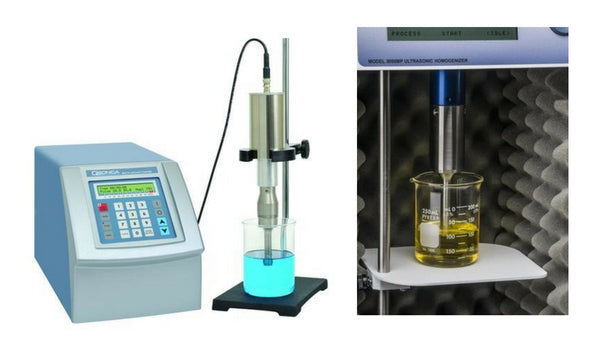To some extent, ultrasonic baths and ultrasonic homogenizers work in a similar manner. They both employ the use of high-frequency soundwaves to achieve the user’s desired results. However, a major difference between the two pieces of equipment lies in the way in which energy is transferred. And this has a large impact on the types of applications for which they are suitable.
We’ll explain more about this energy transfer and the use cases for ultrasonic baths and ultrasonic homogenizers.
Ultrasonic Bath
An ultrasonic bath spreads energy diffusely over a large volume. The mechanism for energy transfer is cavitation, whereby bubbles form and collapse. This can force surface contaminants to release and makes these baths ideal for applications such as cleaning and sterilization preparation. They might also be useful for liquid degassing, cell separation, or cell lysis (of fragile cells).

The ultrasonic bath on the left is designed specifically for cleaning applications. The two on the right can be used for cleaning, but are also suitable for use in cell separation and degassing of liquids.
Ultrasonic baths can offer advantages over ultrasonic homogenizers in many situations. An ultrasonic bath is more appropriate in applications that don't require a lot of power and require diffuse rather than focused energy. Cleaning, where you want to apply the force across the entire surface of an object, is generally one such application.
The diffuse spread of energy means that all surface areas of the submerged item will be thoroughly cleaned. It would be difficult to replicate this with an ultrasonic homogenizer, although probe-based ultrasonic systems are sometimes used for cleaning where a powerful, directed force is called for.
Degassing is another application where a bath is generally preferable. Degassing involves removing suspended gas bubbles from a liquid and reducing the amount of dissolved gas. There can be various reasons for wanting to degas liquids, including removing air from oxygen-sensitive samples, reducing measurement errors caused by gas bubbles, and reducing the potential for microbial growth.
It’s important to note that ultrasonic baths are far less expensive than ultrasonic homogenizers. A Q700 Sonicator (left below), for example, only processes up to one liter and costs almost $5000 when a probe is factored in. You can get a Bransonic 0.5 Gallon Ultrasonic Bath (two right images below) for under $500.

Furthermore, the probes on ultrasonic homogenizers (called "horns") wear over time and require replacement, whereas there are no such consumables in an ultrasonic bath. This is especially valuable in applications where the unit will be in use for a long duration of time, and therefore would cause more wear to the horn. If you can get away with using a bath for your desired application, it would definitely be the most economical option.
There are, of course, limits to what you can achieve with an ultrasonic bath. Because the energy is spread out, only a small amount of energy is imparted on each particle in the sample at a given time. As such, ultrasonic baths can’t achieve small particle sizes and are not typically suitable for applications requiring particle size reduction. Even in cases where they might work, the process would take a very long time.
What’s more, in a bath, the spread of energy is uneven, which means it would be difficult to repeat or scale a given process. This makes ultrasonic baths a poor choice for many applications.
Ultrasonic Homogenizer
An ultrasonic homogenizer (or “sonicator”) involves inserting a probe (or “horn”) into a sample. The probe vibrates rapidly, thereby transferring its ultrasonic energy to the sample. Instead of energy being spread diffusely, the particles directly surrounding the probe get blasted with massive amounts of energy. Bubbles form and collapse in the surrounding solution, creating shear and shock waves. The highly localized intensity of the probe means the sonication process is more efficient and effective than in a bath.
This makes ultrasonic homogenization ideal for particle size reduction and cell disruption. Small particle sizes can be achieved with short processing times. Applications include breaking apart suspended cells, emulsification, and dispersion of nanoparticles.

Left: a Qsonica Q500 Sonicator. Right: a BioLogics 3000MP Ultrasonic Homogenizer which comes with an integrated sound abating chamber.
One example of an ultrasonic homogenizer’s capabilities can be seen in the “gummy bear demonstration.” In this experiment, a 200 watt ultrasonic homogenizer emulsified a gummy bear – submerged in water – in under one minute.
If you were to try this with an ultrasonic bath, you likely wouldn’t have much luck. Even if you could emulsify the bear, it would take a very long time. In contrast, if you were to use an even more powerful ultrasonic homogenizer, you would see even faster emulsification of the bear.
You can learn more about ultrasonic homogenization in our application center.
